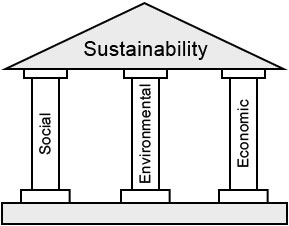
By Jordan Koziej
Jordan is a graduate of the Bachelor of Social Science, Criminal Justice program at Humber. He joined the Sustainability Ambassadors driven by an interest in sustainable living and transportation, and wants the future to be fair and equal for all to enjoy. Jordan believes that housing and transportation should be cheaper so that there is an alleviation of poverty and homelessness, greater access to transit.
Connect with him via LinkedIn.
What is Sustainability?
The word “sustainability” describes being able to attend to our own needs without jeopardizing future generations’ needs. It is a modern term that has roots and a deep history in activism, especially those of social justice, conservationism, and internationalism. Sustainability is made up of the following three pillars:
- Environmental: Earth’s systems are kept balanced, natural resources are able to replenish themselves and ecological integrity is continued and cultivated
- Economic: communities around the world continue their independence, resources are accessible to meet their needs, and systems are intact and easily accessible for everyone (secured sources of livelihood)
- Social: human rights and basic needs are accessible for all to continue healthy and secure communities and families, and community leaders are just and respect the personal, labor, and cultural rights of their citizens

Below are some examples of projects and initiatives with sustainability in their core.
Sustainable Living
The Sustainability Project is run by ambitious community members in the Grey County who want to create positive change. Their projects are aligned with current sustainability narratives for a brighter future – they do this by “cross-pollinating” and providing education and outreach initiatives.
Among their programming, they created a video series called Sustainable Living, where they visit homes with environmental features in the community. One example highlighted are off-grid homes, a term that refers to upgrading home materials, designs and thinking in a goal to moderate air temperatures in households over the year and finding alternative ways of heating to avoid reliance on the electrical and water grid. Carbon footprint of off-grid buildings is minimized due to natural building materials used, wood stoves that heat the entire main level of homes, and other strategies that control the use of electricity. Other features seen in sustainable homes are solar panels, wind turbines, generators (as backup when the panels and turbines do not work), and concrete foundation for additional insulation on the lower levels.

The Summerhill Group develops innovative approaches to assist their customer base is using energy more wisely; making significant positive environmental, business, and consumer behavioral changes. They have several programs available, such as the Home Performance and Assistance Program, that makes it easier for people to use their energy efficiently and reduce costs of their energy bills, even to those considered to be living in low-income dwellings. This is done by installing energy efficient upgrades such as air-sealing and insulation, LEDs, low-flow faucet aerators and showerheads, to electrically heated homes.
Sustainable Transit
Bicycling allows for a sense of freedom, physical activity, and it’s a great form of transportation and recreation, although there is a need for more lanes designated for bicyclists. To ride a bike in Toronto, people don’t need to purchase their own, they can easily rent bikes around the city from Bike Share. Bike Share Toronto is a company that has become a favored transit system in the city with 6,850 bikes, 625 bike stations and a yearly ridership of 2.5 million. Toronto has increased its coverage, which means more sustainable, healthier, and advantageous transit options for other parts of the city including North York, Etobicoke, and the Toronto Islands. With this said, more than 4.5 million pounds of carbon dioxide have been offset due to the renowned bicycling system.

Magnovate is a company that brings a transit technology platform offering high-speed, on-demand, transit systems for people and goods to be transported between urban and regional networks. Their goal: creating sustainable communities that are healthier, cleaner, and more affordable where owning a car isn’t a necessity. They also promise zero emission electric vehicles that renew and reuse energy, vehicles that reduce energy consumption, and are 60% faster than conventional transit – all while promising higher profits and revenue. Toronto is the first North American city to work with Magnovate in creating the Maglev System that will encompass slow-speed last mile systems and urban-commuter high speed inter-city systems. This will bring international attention to Toronto as the city will experience the first high-speed rail in the Country; but it will be first touching the tracks at a very unexpected place – The Toronto Zoo. The new transit is expected to be silent and frictionless, emitting no carbon.

There are multiple ways to embed sustainable values into our daily life through home infrastructure and transit. While the investment cost might be high in transitioning to greener infrastructure, the benefits are priceless: a healthier and more equitable planet for future generations.
